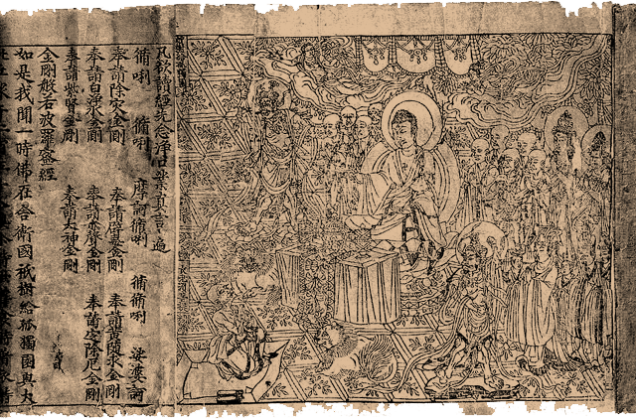Just look around, printed matters are everywhere. If we say that the invention of text has led to the extension of human thoughts and furthermore the profound of it, then the invention of the printing press is undoubtedly enabling more human beings to engage in these thoughts. Printing was originated in China, recognized as the world’s first printed book, the Diamond Sutra Scroll was printed during the Tang Dynasty (868 AD).

The Diamond Sutra
And around 1041 AD, Bi Sheng invented the movable clay-type printing and three hundred years later, movable copper-type was originated. To some extent, movable type was not that successful due to the complexity of the characters used in Chinese. It was not until 15th century that printing press has been spread from China to western countries via Silk Road which later been reinvented by Johannes Gutenberg. A metalsmith from Mainz, Germany, Gutenberg worked over 15 years to perfect the process that produced the first Bible in 1454 with a combination of both old and new technologies. It was an extraordinary example of craftsmanship, far superior to hand-lettered manuscripts, and it signaled not only the printing revolution but a turning point in human history. This new movable type printing spread rapidly across Europe that by 1480, every city in Europe had at least one printing company. (Kovarik, 2016) It didn’t take long for it to lead the Renaissance and later expand all over the world.
In the past, books had difficulties in production as well as dissemination, only the elite could own them. Printing made the production of books thousands of times cheaper. The low prices of printed books enable the public to buy a book at an affordable price and thus ignite the desire of knowledge. In turn, the broken knowledge monopoly has led to a greater demand for religion, science, philosophy, art and literature books. Therefore, a virtuous cycle was formed which accelerated the progress of Renaissance as well as the rise of humanism. Later occurred newspapers and magazines, they have not only greatly eliminated the barriers between individuals and influenced the interaction within a community, but also shed light to the enormous changes in the organization and function of the society. No one could deny how revolution the printing was. However, is printing still revolutionary in an era of Internet? I believe the answer is, NO. The statements about “Printing media is dead” have never come to an end. Also, numerous data showed the steep declines in both traditional advertising income and the need for employees in newspaper and magazines industries. We have to admit that, after five and a half centuries, the printing revolution seems to come to an end.The Internet revolution, like other media revolutions to come, regrouped people and skills. For printing, rather than press work, typesetting, and foundry
The Internet revolution, like other media revolutions to come, regrouped people and skills. For printing, rather than press work, typesetting, and foundry type casting, it is now required design and more importantly to apply information online. Here printing is no longer about putting words and images on paper using ink, but about a broader view that embraces the Internet as most newspaper and magazines have moved to online publication to reach more audience. We used to complain about how heavy books are and the inconvenience for us to bring them around, but now, those burden atoms have become bits that we can carry with us without effort. People can access newspaper and magazines via their phones, tablets and even the wearable devices, glasses and watches. Thanks to them, people are now exposure to news and social trends more frequently as long as they raise their wrist or just simply look the screen on their glasses. Users behavior various through different platforms and therefore the presentation of information matters. In consideration of a social movement, how news shows up on wearable devices may influence users to a large extent.
The Internet revolution is known as the fifth revolution of communication, everything can be connected within and with the Internet. It is a door to future. As a person who grew up with this revolution, the contemporary online-social-mobile media evolution for me is engaging in an era of how an individual being deconstructed into data online and changes data with others. As a normal user, I once admire the “hacker-geek” culture as we use the same Internet but they could utilize it in an advanced way. The modern Internet needs this kind of catalyst to lead the industry to the next step. Though exist the risks, as the social network continuously improve itself while sharing the rules of the real society, risks could be reduced. Once network maybe a small group, or rather, a community, but what we are in now, is a network of the whole world as we are in the global village altogether. It seems that media tend to become more greedier to reach every single person, however, on this lonely planet, a connection is a thing we truly need.
By Yanni Chen, BU Emerging Media Studies Master’s Student, cyannie@bu.edu
Kovarik, B. (2016). Revolutions in communication: Media history from Gutenberg to the digital age (2nd ed.).27-37.
Steinberg, S. H. (1974). Five Hundred Years of Printing (3rd ed.). Harmondsworth, Middlesex: Penguin.
“A Visual History of the Evolution of Printing.” https://www.kaocollins.com/historyofprinting/